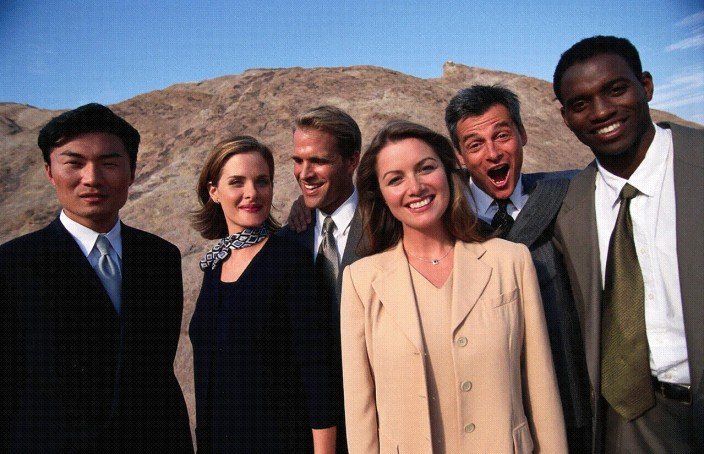We all work with other people.
Whether your business is online or bricks and mortar; whether you run a micro business that is non-location specific on your own, or a small business employing a small or large group of people, at some stage you need to work with others. In your micro-business working from home you might work with a number of outsourced creatives, or the odd consultant – even in that situation you need to co-ordinate, brief, get the right result.
So my contention is that in any business you need to know about teamwork and how to really make it work.
Teamwork is not about getting along together, it’s about getting on with it together. Just being friends who like each other doesn’t make the task any more efficient, just more pleasant.
Teamwork is about everyone working for the same result and looking out for everyone else, stepping into the breach to help when needed, but also recognising each others’ strengths and letting others get on with what they know best. This means that people work to a common timeline and set of objectives, including quality objectives and core values. This means that as your team work on a project or campaign, they stick to schedule, help each other out in areas where their skills are required, and produce their parts of the overall outcome within the quality and other specs required.
Like anything of value, it’s hard to create and easy to destroy!
Over my years working on large-scale change management projects, as well as helping entrepreneurs create their business dreams, I have seen teams being built and operate in that “A” zone, and I believe that there are 4 key factors.
1. Good team work is a “no-blame” culture
This sounds simple but is not easy to achieve. When the pressure is on and something goes wrong, it’s easy, almost “natural” to say “who screwed up?”
But instead, I’ve seen the best teams ask “what can we all learn from this?”
These teams don’t hang people out to dry, they isolate the problem not the person. A blame culture encourages people to hide the problem and cover their mistakes in order to avoid blame. So the reason for failure cannot be fully understood and fixed.
In 1991 the Williams Formula 1 team’s lead driver was Nigel Mansell. At the Portuguese Grand Prix, Mansell was a leading contender for F1 Champion when he made a routine pit stop. Everything appeared normal and as he was signalled to go, he accelerated out of pit lane when his right rear wheel broke off. He had to retire and not only lose the race but ultimately the championship.
The team found that the mechanic fitting the right rear wheel nut had found the nut was damaged and so raised his arm to ask for a replacement. The lollipop man thought the raised arm meant he was ready to go and allowed Mansell to speed off. The team reviewed their procedures and found that the SOP was to have everyone raise their arms when their job was ready – and the lollipop man took that as the signal.
Realising the problem they changed SOP so that only key mechanics who were involved in the last process (tightening the nut) raised their hands.
In a blame culture the mechanic would have been blamed for being “careless” about raising his hand, and the problem of “too many hands” would have continued potentially causing more errors.
That’s not to say there are no consequences – but they are not punishments. The consequences might involve training for example, on the basis that there are no mistakes, only learning situations. However if a cause for failure is human and it keeps repeating despite genuine efforts to fix it, a heart-to-heart performance evaluation might also take place.
2. Real teamwork is essential between sub-teams
Another way of saying this is that the real gains come from how teams work with each other, for example how the sales team works with the marketing team. If they don’t work together schedules get screwed and messages get wonky.
Really good teams have really good sub-teams who communicate regularly about matters that make the whole better. They emphasise activities that create integration and value how each sub-team help the overall outcome be produced.
In the late 1990’s Nissan was a faltering car manufacturer having posted losses in 6 out of 7 years. Even in Japan only 4 out of 43 models were profitable.
In 1999 Carlos Ghosn was appointed to turn them around. He found many causes of their decline, some of which were financial and cultural, which he fixed, but one in particular was causing the decline in their cars’ popularity – they were unatractively designed and badly marketed. One of Ghosn’s initiatives was to restructure their teams. Previously their teams involved separate design, production, marketing and sales teams, and they didn’t talk to each other. In fact several were in separate facilities in different cities. Even though the production team realised the designs they were getting would cost too much to manufacture, they didn’t say anything. Even though the marketing team realised the designs being produced were unattractive to their market, they didn’t say anything. Even though the sales team knew what the market would value the cars at which was below cost, they didn’t say anything. Each team did their job.
Ghosn’s restructure saw representatives of each sub-team form project teams on each model, and allowed information and feedback to flow. This caused new designs, better production values, and better marketing campaigns.
By 2002 Nissan returned to profit and have remained profitable and a leading car manufacturer since.
3. The environment encourages mutual trust
Good teams celebrate team wins, not individual achievements. The way they work involves handing over the task from process to process, trusting the next person to do their job at the same level of quality and commitment. The work process becomes like a human chain of water buckets being passed to the fire – if any one person splashes too much water out of the bucket, there’s less at the end to chuck at the fire.
In the 1980’s Hewlett-Packard or HP was an extremely successful company and its success continues today (with some challenges). It was famous for espousing “The HP Way” which described their vision and values. Founder Bill Hewlett described the reason for their productivity:-
“The dignity and worth of the individual is a very important part of the HP Way…many years ago we did away with time clocks…we introduced flexible work hours. Again this is meant to be an expression of trust and confidence in people. I could cite other examples, but the problem is none by themselves really catches the essence of what the HP Way is all about. You can’t describe it in numbers and statistics. In the last analysis it is a spirit, a point of view. There is a feeling that everyone is part of a team, and that team is HP.”
4. It takes both leadership and management
Leadership is about making sure people do the right thing, management is about doing things right.
It takes both to build a good team.
Leadership sets the values and culture – the way we do things here – and management creates the processes and procedures to get it done on time and right.
Under critical scrutiny it could be said that Ernest Shackleton’s expedition to cross Antarctica in 1915 was a failure. Their ship, The Endeavour was trapped in frozen water off the coast of Antarctica at the very beginning of their expedition, eventually sank trapping the crew on the ice, and only after several attempts did they manage to send a party to South Georgia island 800 miles away to deliver a message that led to their rescue.
Yet beneath those bare facts, Shackleton led 28 shipwrecked men in dangerous conditions over 20 months without any death or serious injury, and eventually caused their rescue.
After 16 months on the ice, after having survived a winter in Antarctica with meagre supplies, met a near-mutiny, and moved the men off the ice to Elephant Island over rough seas, Shackleton decided to launch a small party in a boat to sail to South Georgia Island 800 miles away. Up to this point, having kept his men’s morale up, instilled discipline and giving them hope, his men had already written in their diaries “I could not fail to admire the calm poise that disguised his anxiety…I realised the loneliness and penalty of leadership”, and “his unfailing cheeriness means a lot to a band of disappointed explorers like ourselves…he is one of the greatest optimists living.”
Now leading a small party of men in the lifeboat the James Caird, he turned to management. He took time to choose his companions for their usefulness (carpenter and sailing ability, physical strength, navigational skill, indomitable character), split the rations between the party staying and his boat calculating amounts required to keep both alive, and issuing instructions with timelines to the remaining party.
As required, he showed the characteristics of good leadership providing the men with an optimistic vision, leading by example, allowing the flow of good and bad information, and planning routes of best escape. When required he displayed management ability by organising human resources and supplies, negotiating near-mutineers, and project planning.
In August 1916 he returned with another ship to rescue the stay-behind party.
So when you get to work, look around you, or look at your projects board, to see who’s working in your team or which outsourcer is working on your projects. Ask if you and these people form a good team? Are you leading and managing as required in each situation? Is there mutual trust that they know what you need and you know what they can do? Is there enough communication and information flow? What happens when things go wrong?
Work on these things and you’ll find that things just “flow” – and, it’s a lot more fun!
I know, when you are in business a lot of these things catch up with you, you just don’t have enough time to think about teamwork as well as sales, and don’t forget the the taxes! Well I’m here to tell you that there are systems and procedures and templates that you can use to model each of these business issues that are combining to overwhelm you. Why not join the hundreds of entrepreneurs and small business owners who are finding these systems and models, just click here.
And, get over to teikoh.com to see all the free resources to help you formulate strategy, provide leadership, and grow your business.
Facebook
Google+
Pinterest
LinkedIn





No comments yet.
Add your comment